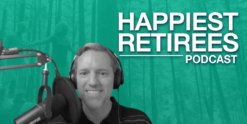It’s a new year, and with it comes new opportunities for people all over the country to set retirement goals.
Financial gurus and critics tell us we need millions of dollars to stop working. Whether it’s a scary article in the Wall Street Journal making the case against withdrawing retirement funds or Suze Orman practically demanding you work a shift at your own funeral, at a certain point, we have to wonder what the point of working and saving is if we can’t ever enjoy it.
It’s time to turn down the volume on the hyperbole. The truth is, we can find a happy medium. Regular folks can retire sooner and happier than they ever thought possible.
There are various methods to accomplish this overarching goal, but those who follow certain foundational principles tend to have incredible luck reaching happiness in retirement. I cover the topic extensively in my first book, You Can Retire Sooner Than You Think: The 5 Money Secrets of the Happiest Retirees, but I wanted to share a little with you here to start your new year off on the right foot.
1. No Mortgage
You’ve got to find a way to eliminate the pesky bill that haunts your dreams every month. Regardless of the original loan balance, happy retirees will likely be within five years of paying off their mortgage as they approach their last day at the office. The best way to accomplish this is to pay above and beyond the minimum required monthly payment. If this is possible for you, it’s typically one step closer to a happy retirement.
Chisel away at that principle to ensure the payoff is within reach when planning to retire. It should give you more financial flexibility and provide the peace of mind of knowing you own your home free and clear.
2. How Much Money Do You Need?
I’ll give it to Suze Orman that transitioning to retirement with millions in savings would be easier than doing it with $20,000. That said, most of us don’t have the option of living on a private island in the Bahamas, so what’s a realistic amount? My research shows that the magic number is closer to $500,000.
Some folks might need help finding this figure attainable. Don’t worry. I’m not saying it’s impossible to have a happy retirement with less. Based on the happy retirees I’ve surveyed and studied, that amount allows for enough of an income stream to replace your paycheck when supplemented with Social Security. Having $500,000 in retirement savings should generate approximately $2,000 in monthly income. That math looks like this:
$500,000 x 5%* = $25,000 annually.
*We use 5% in this exercise as an example. From what I’ve seen during my 20 years of helping people plan for retirement, using a dynamic approach to your nest egg is the key. Anywhere from 4% to 5% should be sustainable so long as you are willing to make adjustments as needed. As always, please consult with a financial advisor before making a decision like this.
$25,000 / 12 months = $2,083 per month in income.
For example, if you and your spouse each receive $1,500 monthly in Social Security, that totals $3,000. Adding that to the $2,000 puts you at $5,000 per month. That might not seem like a ton of money, but remember that if you’ve followed the first principle, you don’t have a mortgage payment. Imagine how far $5,000 can go without that big monthly expense!
Now, if you want to retire before you can draw Social Security, that’s okay as long as you account for the extra income you’ll need to find elsewhere.
3. Core Pursuits
Core pursuits are the activities you’re passionate about that bring you excitement and a sense of fulfillment. Think of them as hobbies on steroids. So whether it’s woodworking, windsurfing, chess, golf, tennis, music, travel, or volunteering, all these and more count as core pursuits.
My research found that unhappy retirees average 1.9 core pursuits, whereas happy retirees average closer to 3.6. The difference between those two numbers is enormous.
Having a purpose and an outlet for the financial resources you’ve worked so hard to accumulate is a crucial part of happiness. Getting the first two principles locked down means you have sufficient financial footing, but instead of writing a check to the bank, you can spend your time and money creating memories and pursuing passions.
All this may sound simple, but it takes a long time to get there. That’s why you don’t see many forty-five-year-olds retiring. I’ve witnessed so many people able to accomplish it by their late fifties and early sixties, and there’s no reason you can’t be one of them.
There are always exceptions, but these tools have worked repeatedly. It doesn’t mean there aren’t some who do it quicker and cheaper and some who need more to pull it off. Situations can vary for those living in the extremes — affordable areas vs. the heart of Manhattan or San Francisco. But, in general, these baseline numbers can be very effective retirement tips for most people in the U.S.
Take the bull by the horns in 2023! Enjoy a more detailed roadmap for financial stability and happiness in retirement by picking up either of my books, including my latest, What the Happiest Retirees Know: 10 Habits for a Healthy, Secure, and Joyful Life.
Happy New Year!
This information is provided to you as a resource for informational purposes only and is not to be viewed as investment advice or recommendations. Investing involves risk, including the possible loss of principal. There is no guarantee offered that investment return, yield, or performance will be achieved. There will be periods of performance fluctuations, including periods of negative returns and periods where dividends will not be paid. Past performance is not indicative of future results when considering any investment vehicle. This information is being presented without consideration of the investment objectives, risk tolerance, or financial circumstances of any specific investor and might not be suitable for all investors. There are many aspects and criteria that must be examined and considered before investing. Investment decisions should not be made solely based on information contained in this article. This information is not intended to, and should not, form a primary basis for any investment decision that you may make. Always consult your own legal, tax, or investment advisor before making any investment/tax/estate/financial planning considerations or decisions. The information contained in the article is strictly an opinion and it is not known whether the strategies will be successful. The views and opinions expressed are for educational purposes only as of the date of production/writing and may change without notice at any time based on numerous factors, such as market or other conditions.














